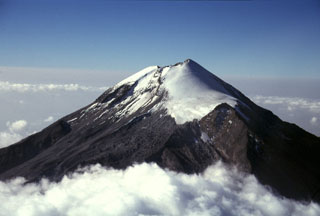Report on Pico de Orizaba (Mexico) — April 1994
Bulletin of the Global Volcanism Network, vol. 19, no. 4 (April 1994)
Managing Editor: Richard Wunderman.
Pico de Orizaba (Mexico) Low seismicity, no fumarolic activity, and no crater changes
Please cite this report as:
Global Volcanism Program, 1994. Report on Pico de Orizaba (Mexico) (Wunderman, R., ed.). Bulletin of the Global Volcanism Network, 19:4. Smithsonian Institution. https://doi.org/10.5479/si.GVP.BGVN199404-341100
Pico de Orizaba
Mexico
19.03°N, 97.27°W; summit elev. 5564 m
All times are local (unless otherwise noted)
Seismic activity was monitored on 22-24 April using one station located at 4,480 m elevation on the S flank. The station consisted of a 1-Hz vertical component seismometer, operating at 78 dB amplification with a band-pass filter between 0.3 and 30.0 Hz. The station registered five B-type events within a 5.5 hour time period on 23 April, and three events within 15 minutes of each other on 24 April. Coda duration was 10-18 seconds long; frequencies were in the 3-6 Hz range. Maximum peak-to-peak amplitudes measured 1-3 mm.
Observers who ascended to the summit found no fumarolic activity. Crater morphology was unchanged since visits in October 1992 and 1989. Water discharge from the "La virgen" spring at 4,400 m elevation had decreased to 0.5 liters/hour from 10 liters/hour in 1992.
Geological Summary. Pico de Orizaba (Volcán Citlaltépetl), México's highest peak and North America's highest volcano, was formed in three stages beginning during the mid-Pleistocene. Orizaba lies at the southern end of a volcanic chain extending north to Cofre de Perote volcano and towers up to 4400 m above its eastern base. Construction of the initial Torrecillas and Espolón de Oro volcanoes was contemporaneous with growth of Sierra Negra volcano on the SW flank and was followed by edifice collapses that produced voluminous debris avalanches and lahars. The modern volcano was constructed during the late Pleistocene and Holocene of viscous andesitic and dacitic lavas, forming the current steep-sided cone. Repetitive explosive eruptions beginning during the early Holocene accompanied lava dome growth and lava effusion. Historical eruptions have consisted of moderate explosive activity and the effusion of dacitic lava flows. The latest eruption occurred during the 19th century.
Information Contacts: Guillermo González-Pomposo1 and Carlos Valdés-González, Departamento de Sismología y Volcanología, Instituto de Geofísica, UNAM, Cd. Universitaría, 04510 D.F., México; 1 Also at Benemérita Univ Autótonoma de Puebla, México.

